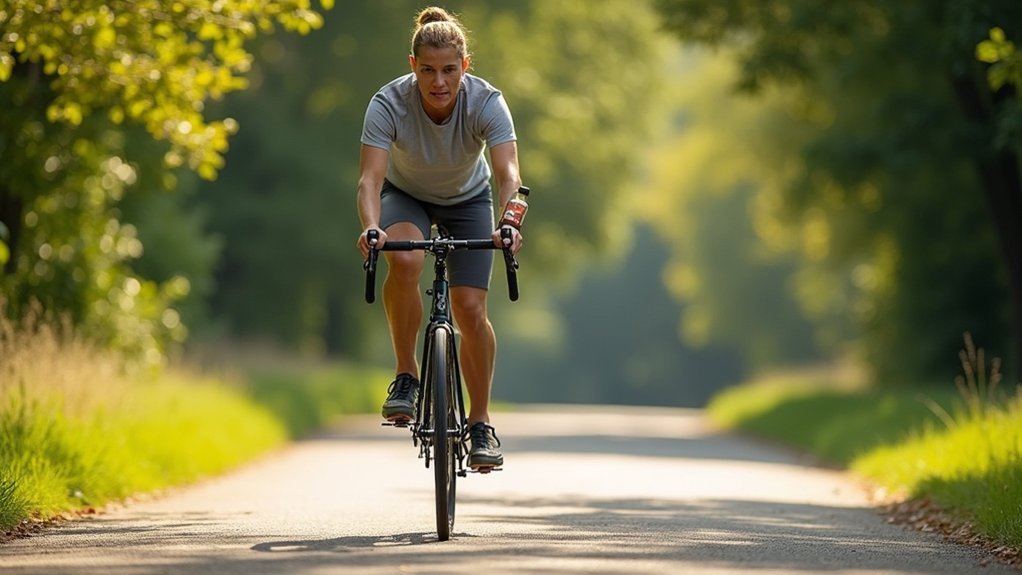Three key tips for low-impact cycling with chronic illness: First, customize your bike with proper seat height and handlebar position to minimize joint strain. Second, start with brief 5-10 minute sessions, gradually building to 150 weekly minutes with rest days between rides. Finally, listen to your body daily, adjusting intensity during flare-ups and celebrating small victories like maintaining proper form. These foundations will help transform cycling into a sustainable part of your wellness journey.
The Science Behind Low-Impact Cycling for Chronic Conditions

While many exercise options exist for those managing chronic conditions, low-impact cycling stands out as particularly beneficial due to its unique combination of cardiovascular benefits and joint protection.
Research shows this form of exercise minimizes stress on your joints while still improving cardiovascular fitness—making it ideal if you’re managing arthritis or similar conditions.
Low-impact cycling delivers cardiovascular benefits without stressing joints—perfect for arthritis management.
When you cycle regularly, you’ll likely experience improved insulin sensitivity and better blood sugar regulation, which is essential if you’re managing diabetes.
The low-impact nature of cycling strengthens muscles around key joints, potentially reducing pain and improving function for chronic pain sufferers.
Beyond physical benefits, cycling positively affects your overall health by reducing stress and anxiety levels—a significant advantage when coping with chronic illness.
The adaptability of cycling allows you to gradually increase intensity as your condition permits.
Customizing Your Bike for Maximum Comfort and Support
Customizing your bike setup can transform your cycling experience when managing chronic illness.
You’ll find significant relief by adjusting your seat height for proper leg extension, raising handlebars for an upright position, and adding shock-absorbing accessories like gel seat covers.
These personalized modifications work together to reduce joint strain, minimize pressure points, and create a more sustainable exercise option that accommodates your specific health needs.
Adjustable Seat Positioning
For those managing chronic illness, proper seat positioning becomes essential rather than optional when cycling. Your seat’s configuration directly impacts joint stress, muscle engagement, and overall comfort during rides.
Optimize your adjustable seat positioning with these key adjustments:
- Set your seat height so your leg remains slightly bent at the bottom of the pedal stroke, reducing knee strain while maximizing power transfer.
- Position the seat horizontally to align your forward knee directly over the ball of your foot when pedals are parallel to the ground.
- Maintain a level seat tilt or slight downward angle to prevent lower back pain and pelvic pressure.
- Consider a wider, cushioned seat for additional support, especially helpful for longer rides.
Remember to reassess your seat position regularly as your body and fitness levels change throughout your cycling journey.
Handlebar Height Matters
The three key dimensions of bicycle customization all matter, but handlebar height stands out as particularly essential for chronic illness management. When adjusted thoughtfully, your handlebars can dramatically reduce strain on your back, neck, and shoulders during rides.
If you’re managing chronic pain, consider raising your handlebars to promote a more upright position. This adjustment alleviates pressure on wrists and hands—particularly beneficial if you have arthritis or similar joint discomfort.
For ideal comfort, keep your handlebars at or slightly below saddle height to encourage proper alignment of your spine.
As your fitness changes or symptoms fluctuate, don’t hesitate to reassess your handlebar height. What worked yesterday mightn’t work tomorrow.
Making these small adjustments can transform your cycling experience and help you ride comfortably for longer periods.
Shock-Absorbing Accessories
Beyond proper handlebar positioning, outfitting your bike with shock-absorbing accessories transforms riding comfort for those managing chronic illness.
These ergonomic modifications can greatly reduce discomfort and help you maintain an active lifestyle despite back pain or other conditions.
Consider these essential upgrades:
- Install a shock-absorbing seat post to minimize spine impact when riding over bumps and uneven terrain.
- Add ergonomic grips to alleviate wrist strain during longer rides.
- Invest in a gel or memory foam saddle cover for improved cushioning and support.
- Switch to wider tires with lower pressure to absorb road vibrations.
Customizable stems and handlebars allow for personalized positioning that reduces strain on your shoulders and back.
These modifications work together to create a more forgiving ride experience, making cycling accessible even when managing chronic conditions.
Building a Progressive Cycling Routine for Limited Energy
When managing chronic illness, establishing a sustainable cycling routine requires careful attention to your body’s energy limits. Start with just 5-10 minutes of low intensity cycling, which can help you stay active without depleting your resources. A stationary bike offers controlled exercise options that maintain overall function while minimizing unpredictability.
Gradually increase your time on the bike, aiming for the recommended 150 weekly minutes of moderate activity. Incorporate at least one full rest day weekly—your recovery is as important as the exercise itself.
Consider trying gentle intervals, alternating 1-2 minutes of slightly increased effort with 3-4 minutes of easy pedaling. Remember, consistent, manageable sessions at a steady pace will yield better long-term results than pushing beyond your capacity.
Managing Pain and Fatigue During Cycling Sessions

Pain and fatigue often present significant barriers to maintaining an active cycling routine with chronic illness. To manage pain while enjoying the low impact benefits of cycling, start with brief 10-15 minute sessions and gradually increase duration as your body adapts.
Living with chronic illness doesn’t mean giving up cycling – it means adapting your approach to honor your body’s needs.
- Prioritize proper bike fit to minimize discomfort and reduce your risk of injury during rides.
- Listen to your body by tracking pain and fatigue levels, identifying patterns that help you adjust your routine accordingly.
- Take strategic breaks during your ride to stretch and recover, preventing stiffness from compromising your overall health.
- Support your cycling efforts with proper hydration and nutrition to combat fatigue and enhance recovery between sessions.
Remember that even short rides can provide significant benefits while helping you manage pain effectively.
Breathing Techniques to Enhance Your Cycling Experience
Although many cyclists focus primarily on pedaling technique and posture, proper breathing can transform your cycling experience, especially if you’re managing a chronic illness.
Deep diaphragmatic breathing enhances oxygen delivery to muscles, improving endurance during low-impact cycling sessions.
Try the “4-2-4” technique—inhale for four counts, hold for two, exhale for four—to promote relaxation and control anxiety while riding.
Practicing rhythmic breathing by coordinating your breath with pedal strokes helps maintain steady cadence and reduces fatigue.
Don’t forget to focus on exhaling fully to clear carbon dioxide more effectively, enhancing overall respiratory function.
Incorporating breath awareness into your routine increases mindfulness, keeping you present and attentive to your body’s signals.
These breathing techniques can make your low-impact cycling sessions more beneficial and enjoyable.
Adapting Your Cycling Goals to Flare-Up Days

When your body signals a flare-up, it’s crucial to adjust your cycling expectations rather than abandoning your routine entirely.
Success on these challenging days isn’t measured by distance or speed, but by simply showing up and moving your body in whatever capacity feels manageable.
You’ll benefit more from a five-minute gentle ride that respects your limits than from pushing through pain that might extend your recovery time.
Listen to Your Body
Living with chronic illness means your cycling routine will inevitably encounter days where your body demands different treatment. When flare-ups occur, listen to your body and adjust cycling intensity accordingly to prevent exacerbating symptoms. Your physical capabilities will fluctuate, requiring flexibility in your approach.
- Reduce duration and pace on difficult days, perhaps cutting your usual route in half or selecting flatter terrain.
- Incorporate rest days between rides, allowing your body time to recover fully.
- Monitor pain signals during your ride – discomfort that worsens or persists is your cue to stop.
- Track your experiences in a journal to identify patterns that help you manage chronic illness symptoms effectively.
This mindful approach guarantees cycling remains beneficial rather than detrimental during challenging periods.
Redefine Success Daily
Success in cycling with chronic illness takes on new meaning when you experience flare-ups. On challenging days, redefine success by setting achievable goals that respect your body’s limitations. Perhaps today’s win is a 10-minute gentle ride rather than your usual 30-minute session.
Utilize a stationary bike for low-impact cycling when outdoor rides feel overwhelming. This controlled environment allows you to focus solely on movement while carefully monitoring your energy levels.
Remember that consistency trumps intensity—regular, gentle physical activity provides more long-term benefits than occasional intense workouts.
Track your daily progress without judgment, adjusting expectations as needed. Celebrate small victories, whether it’s maintaining proper form or simply showing up.
On particularly difficult days, consider alternative low-impact activities that still keep you moving while honoring your body’s needs.
Indoor vs. Outdoor Cycling: Which Works Better for Your Condition?
Choosing between indoor and outdoor cycling can considerably impact how you manage your chronic illness. Both offer unique benefits tailored to different health needs.
- Environment Control: Indoor cycling provides consistent temperature and protection from weather, making it ideal for those with respiratory chronic conditions who need predictable environments.
- Mental Health: Outdoor cycling immerses you in nature, boosting mood and reducing stress—valuable benefits if you’re managing anxiety alongside physical symptoms.
- Customization: Indoor cycling offers precise resistance adjustment, creating truly low-impact workouts that protect vulnerable joints while building strength.
- Support Systems: Group indoor cycling classes provide social motivation and accountability, which can help you maintain consistency when fatigue makes exercise challenging.
Consider your specific health limitations, daily symptoms, and personal preferences when deciding which cycling environment will serve you best.
Tracking Your Progress: Meaningful Metrics Beyond Speed and Distance
When managing a chronic illness, traditional cycling metrics like speed and distance often fall short in measuring true progress. Instead, focus on monitoring your heart rate to stay within a safe intensity zone that supports your overall health without triggering flares.
Track session duration rather than distance—spending more time on your bike indicates improving endurance. Use the Borg Rating of Perceived Exertion scale to measure how hard you feel you’re working, which is particularly valuable when conventional metrics might be discouraging.
Pay attention to recovery time—if you’re bouncing back faster after rides, your fitness is improving.
Finally, log your mental well-being before and after cycling sessions. Many people with chronic conditions report significant mood improvements from regular cycling, making this emotional metric just as important as physical ones.
Frequently Asked Questions
What Is a Low-Impact Workout for Chronic Illness?
Low-impact workouts for chronic illness include exercises that don’t stress your joints. You’ll benefit from activities like swimming, walking, or yoga that improve mobility and strength while managing your symptoms effectively.
What Is the Best Exercise for Chronic Illness?
You’ll benefit most from swimming, cycling, and walking as they’re gentle on your joints while boosting cardiovascular health. Choose activities you enjoy and can sustain consistently, adjusting intensity based on your energy levels.
How to Thrive With Chronic Illness?
To thrive with chronic illness, you’ll benefit from establishing consistent routines, practicing self-compassion, building a support network, setting realistic goals, and finding joy in small victories. Don’t forget to prioritize rest when needed.
Is 30 Minutes of Cycling a Day Enough?
Yes, 30 minutes of cycling daily is enough to boost your cardiovascular health, manage weight, improve mental wellbeing, and build muscle strength. It’s an effective workout that delivers significant benefits without overwhelming your schedule.
In Summary
Remember, low-impact cycling isn’t about competing with others—it’s about honoring your body’s unique needs. You’ve now got tools to customize your bike, manage your energy, and track meaningful progress. Whether you’re riding indoors during flares or enjoying outdoor sessions on good days, you’re building resilience with every pedal stroke. Listen to your body, celebrate small victories, and keep moving forward at your own pace.





Leave a Reply